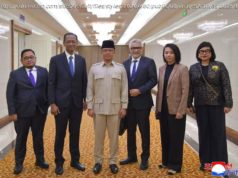Photographic analysis of North Korea’s new intercontinental ballistic missile (ICBM) reveals the nose cone of the nuclear-capable rocket appears similar to a suspected Chinese-supplied warhead for a Pakistani nuclear-capable missile.
Photographic analysis of North Korea ’s new intercontinental ballistic missile (ICBM) reveals the nose cone of the nuclear-capable rocket appears similar to a suspected Chinese-supplied warhead for a Pakistani nuclear-capable missile.
Missile analyst Rick Fisher, a senior fellow at the International Assessment and Strategy Center, tells Inside the Ring the warhead stage of the new ICBM, dubbed Hwasong-14 and flight-tested with great fanfare July 4, appears very similar to the last stage of a missile tested in January by Pakistan.
The Pakistani medium-range Ababeel missile was flight-tested Jan. 24 and is assessed to be capable of carrying either a conventional or nuclear warhead.
The warhead stage similarities suggest “there is a real possibility that North Korea and Pakistan are continuing their historic cooperation in the development of long-range ballistic missiles, ” Mr. Fisher said.
Mr. Fisher said Asian intelligence sources told him that the third warhead stage of the Ababeel is liquid-fueled and was launched atop two solid-fuel stages developed from Pakistan’s Shaheen II or Shaheen III medium-range missiles.
The new Hwasong-14 appears to use three liquid-fuel stages, and the nose cone shown in state-run North Korean video reveals it is nearly identical to the new Pakistan missile nose cone.
“What is important to note is that, according to Indian sources, Ababeel demonstrated either a multiple-warhead capability or the ability to deploy decoys along with a single warhead, ” Mr. Fisher said.
The multiple-warhead capability for the Ababeel is likely sourced to China, which has provided Pakistan with nuclear weapons and other missile technology for several decades, he added.
“It is also possible that China could have given this technology to North Korea originally, using a Pakistan test as a means to further conceal the technology origin, ” Mr. Fisher said, noting it is “very unlikely” such multiple-warhead technology could have been developed indigenously by either Pakistan or North Korea.
“ China ’s goal has been to create ever greater deniability regarding its proliferation of missile and nuclear technologies by enabling North Korea, Pakistan and Iran to become nuclear missile states via their discreet sharing of technologies, much of which comes from China, ” he said.
Another clear sign of Chinese collusion with the North Korean and Pakistani missile programs is the fact that both mobile launchers used to fire the Hwasong-14 and Pakistan’s Shaheen III appear to be made by the Sanjiang Special Vehicle Corp. of the China Aerospace Science and Industry Corp., China ’s main missile maker.
Despite the disclosures of covert Chinese exports of mobile launchers since 2012, the U. S. government had taken no action against Beijing .
“What matters for American security planners is that North Korea ’s Hwasong-14 ICBM may begin its career with a multiple warhead capability — technology that will likely be improved as North Korea develops its solid fuel and mobile medium-range and intercontinental-range ballistic missiles, ” Mr. Fisher said.
A mobile ICBM capability for North Korea greatly increases the danger of a surprise nuclear attack.
The North Korean regime of Kim Jong-un for years has threatened to conduct nuclear attacks on the United States and has produced videos simulating nuclear strikes on American cities.
EMP threat from North Korea
Largely overlooked by both government and private missile analysts concerning the new North Korean long-range missile is the danger that Pyongyang will use the system to conduct a devastating electromagnetic pulse, or EMP, attack rather than a missile-delivered nuclear ground burst.
Peter Pry, a former congressional staff member who helped lead a commission on EMP, believes initial assessments of the new North Korean missile’s range are incorrect. Current estimates are the Hwasong-14 has the range to reach all of Alaska.
The Pentagon announced that the new ICBM initially was assessed as an intermediate-range missile with a range of between 1,800 and 3,400 miles. Later analysis, however, revealed the missile has a range of greater than 3,400 miles — considered intercontinental range.
“Perhaps, most importantly, none of the analysis of the threat posed by North Korea ’s ICBM considers the possibility it could be used to make an EMP attack, ” Mr. Pry told Inside the Ring.
“Most analysts are still predicting a North Korean ICBM threat to the U. S. heartland is still several years away because, supposedly, the North still has to develop a re-entry vehicle and accurate guidance system to hit U. S. cities, ” he noted.
However, an EMP attack involves setting off a warhead at high altitude, some 20 miles to 250 miles in space, and does not require a re-entry vehicle.
Accuracy also is not required as an EMP strike can affect all electronics over an area stretching hundreds of square miles.
“Indeed, a North Korean missile would not even have to reach the continental United States to make an EMP attack that could black out the electric grid for months or years, endangering millions of Americans, ” he said.
“A weapon detonated at high altitude over the Pacific or over Canada could be hundreds of kilometers distant from the U. S. mainland and still project an EMP field deep into the United States. EMP is the threat here and now that everyone ignores.”
Former CIA Director James Woolsey said focusing on the North’s new missile’s range misses the point. Pyongyang already has missiles capable of orbiting a nuclear device that could be used in an EMP attack.
“ North Korea can hit the electrical system of the United States just by detonating a nuke over the central part of the country, ” he said.
New START numbers
Russia has added 15 new missiles or bombers to its nuclear forces since September, according to the latest State Department fact sheet on the New START arms treaty.
Moscow also continues to maintain a stockpile of deployed nuclear warheads that is 354 warheads larger than current U. S. stocks.
The latest New START numbers were published July 1 and show the United States currently has 1,411 deployed warheads compared to Russia’s 1,765 deployed warheads.
Both the U. S. and Russian warhead stockpiles must be reduced to 1,550 warheads by February under the 2010 arms treaty. The U. S. side is already below the treaty limit.
The latest figures show that Russia cut back the number of its deployed warheads from 1,796 in September to 1,765 warheads by March 1.
The number of U. S.-deployed warheads increased by 44 weapons between the same period, from 1,367 in September to 1,411 in March.
For strategic missile launchers and heavy bombers, Russia decreased the numbers from 847 in September to 816 in March.






